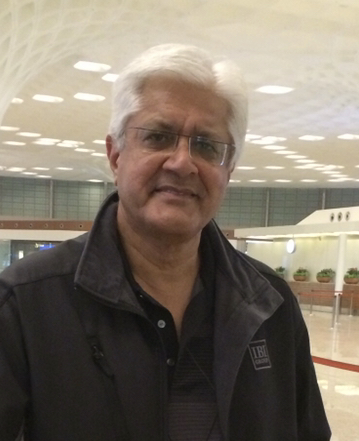Shabir Premji was born in Tanzania, East Africa and lived in Moshi, a town nestled in the foothills of Mt. Kilimanjaro. At 17, he moved to England to finish high school and then received his accounting designation from the Institute of Chartered Accountants in England and Wales.
In 1978, Premji immigrated to Canada and arrived in Calgary, AB. He commenced working at the accounting firm, KPMG and was a Senior Manager, when he left to join a client of the firm in 1987. He was the Vice President of finance for a manufacturer of oil pipeline valves for the next four years until that company was sold, Premji began his path of entrepreneurship by purchasing and running a cabinet manufacturing company for approximately five years. At the same time, he started his first oil company that eventually spawned into three different oil companies and two gas marketing companies. He sold these companies in the late 90’s.
In 2003, he started his first public company, Platform Resources Inc. which became Alberta Oilsands Inc. Over the next seven years, he took his company from its initial $1 million public raise to a market value of approximately $150 million before retiring. Then in 2012, he joined Groundstar Resources Ltd as their CFO and director and resigned in 2015.
Premji is currently the Chairman & CEO, Director, and Founder of P Squared Renewables Inc., a publicly listed company on the TSX_V exchange in Canada which commenced operations in 2016. In his free time, he enjoys playing golf and squash and assisting with various charitable organizations.
https://www.linkedin.com/in/shabir-premji-5374b019/
What does a typical day look like for you?
I start the day with half an hour in meditation. Typically, I get to the office around 9 a.m. I would have put together my to-do list the previous day as I like to know what my next day is going to look like. I spend the day addressing business matter, attending meetings, and looking into any new opportunities that come across my desk. I either leave the office at 4:30 or 5 p.m., depending on whether I’m going to the gym that day. I try to go to the gym at least three times a week. Then its home, dinner with the family and completing the evening reading, watching TV and attending to personal matters.
How did you get started in the renewable energy industry?
Funnily enough, I was sitting on the beach in Mexico when it came to me. I’m very interested in politics, how the world is evolving, various trends, et cetera. I have a theory that where there is a consensus of opinion by governments to go a certain way and it’s a global consensus, then that is where business opportunities lie. So, currently the world is focused on productivity gains, health care, climate change, security and other such areas. All of these spawn solutions coming from the knowledge economy. Technology and its applications. That is the future. We had the agrarian revolution followed by the Industrial revolution and know we have the knowledge economy. Getting back from that Segway, at the Paris conference, every country in the world signed off, saying that we are concerned about climate change. We want to do something about it. We know that fossil fuels, which were to date the energy delivery source and mechanism needed to be replaced over time or the necessary technology applied to ensure that there were zero emissions from their use.
So, here was this industry that had spawned about ten years previously that is now getting a lot of attention, not only by governments but also by private organizations. It is a very altruistic type of industry, helping the globe stay blue. So, I started looking into it and reaching out to people who are in the industry, and that’s how I started.
Where did the idea for P-Squared Renewables Inc., come from?
So, I read several journals, and I try to learn what the trends are. My background is from the energy industry, and I know that the world cannot do without oil and gas right now. The world is using nearly a hundred million barrels of oil per day plus natural gas and coal to heat our homes drive our cars and provide electricity for our industries. It’s a necessity now, but we have the technology to start changing these input sources for energy production. I wanted to be part of the solution. I wanted to see if there were prospects to bring the solar, wind, storage solutions into a wider distributed energy solution.
What trend(s) in renewable energy are you most excited about?
As far as wind and solar energy are concerned, these two sources of energy are what we call variable energy sources. What that means is they don’t have the ability to produce constant energy for you. So, what you then need is what is called baseload, which is something that comes from coal-fired, natural gas-fired, hydro-electric dams and nuclear power plants. Either you have to marry an older-style baseload with variable energy as a supplemental source, or you have to provide yourself the ability to store the energy that you produce when the wind blows and the sun shines and store it for when it is required. Essentially, that is what we do when we build a hydro-electric dam. We store the water so that it is constantly going through the turbines to produce base-load electricity. This aspect of the renewable energy industry is most exciting to me. The technology is still very much in its infancy stage. It’s like Tesla having the ability to crank up the number of miles a car can go off their battery. It’s figuring out and discovering what technology can applied be applied to enhance efficiency and to be able to store and retain as much power as possible for as long as possible.
How do you motivate others to achieve their fullest potential?
I believe that comes with leadership. It’s being able to convey a vision to your team and having their buy-in. One must be able to convey to people one’s vision, how the company and the people within the Company will be able to attain that vision If you’re able to convey that your team, then you can create a situation where people are excited about what they’re doing and excited to come to work in the morning. That is the key to building a successful company.
What other CEOs do you admire, and why?
I admire CEOs who break barriers and make fundamental changes to help make the world a better place. So, based on that, right now, the three CEOs that I follow the most are Jeff Bezos of Amazon, Elon Musk of Tesla, and Satya Nadella of Microsoft.
What is your style of leadership, and how did you determine it was the most effective for you?
I am a big believer in giving people the opportunity to excel. That process is only fair if the responsibility and goals are clearly defined, progress is regularly monitored and relayed back. I like to bring on people who are self-starters and who can take a project and run with it, and we provide them with the resources and authority to execute.
How do you remain productive?
You can’t be constantly productive. You have to have some playtime, and you have to have some downtime. So, I’m very insistent that people take their vacations, spend time with their families. In the long run, it keeps people motivated and productive, and the chances of burn out are greatly reduced.
What aspects of renewable energy does P-Squared specialize in?
Right now, we are looking at going into the storage side of the business. One thing we’re looking into and working on is how to take municipal waste and convert it back into fuel.
How does renewable energy storage differ from traditional energy storage?
For renewable energy, it depends on the energy source being utilized. It is all about what kind of potential energy is being converted into kinetic energy. For example, if you convert solar and wind into electrons, the idea then is to store those electrons. With a hydroelectric dam, you’re storing the water and then releasing it over turbines, so that’s another method of storing energy. Now, if you look at traditional energy, such as fossil fuels (coal), the potential energy is retained in the material itself and released when you burn that Coal. So, the energy is empirical; it’s already stored there. It’s the same thing with oil and gas. Thus, if I were to summarize, traditional energy is stored within the material itself, and renewable energy is stored after you capture the energy and convert it.
Where do you see yourself in five years?
I hope to be with a company that is well immersed in being one of the leading Canadian renewable energy companies. We want to bring renewable energy solutions to the Canadian environment. Canada is a vast country and transmission of electricity over long distances is very expensive. Renewable energy lends itself very well to a solution that employs the concept of producing energy where it is required. British Columbia, Ontario and Quebec have ample hydroelectricity capacity there. The Prairie Provinces, Alberta, Saskatchewan and Manitoba, as well as the Maritimes provinces and Northern Canada have ample wind and sunshine. We hope to bring distributed energy production to that landscape.


